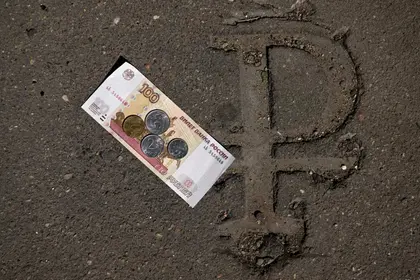On August 8, Putin raised eyebrows and rattled the ruble, by transferring artillery and attack helicopters from Wagner Group mercenaries to Rosgvardia, a national guard that reports to him only and is bigger than the Russian military. Then on August 23, the Wagner Group was decapitated when a jet, “apparently” carrying its founder Evgeny Prigozhin and his top leaders, was shot down over Russian airspace. The mercenaries angrily responded that he “died as a result of the actions of traitors to Russia” — which foreshadows internal trouble ahead. But Prigozhin’s death, if real, consolidates Putin’s control, and took place the day before Ukraine’s Independence Day, an unspoken commitment to Russia’s unsuccessful and unaffordable war. Now Russia’s biggest vulnerability is financial. On August 17, Russia’s central bank panicked and raised interest rates to avert a currency meltdown. Now Ukraine targets Russia’s maritime routes for oil exports, Putin’s only source of income. An asymmetrical naval war is underway, aimed at sinking ships and the ruble, and Ukrainians have an advantage.
 |
In recent days, Ukrainian sea drones damaged three military ships and drove away six civilian ships. Its aerial drones routinely swarm four Russian regions destroying aircraft, grounding many more, and forcing Moscow airports to divert flights. The target is to disrupt Russia’s “cash flow” by impeding oil exports to China and India that prop up Russia’s economy and war effort. Peppering Russians with these devices is also a form of psychological warfare and has unnerved the public.

EXPLAINED: What We Know About Russia’s Oreshnik Missile Fired on Ukraine
JOIN US ON TELEGRAM
Follow our coverage of the war on the @Kyivpost_official.
Putin’s 18-month-old “special military operation” has destroyed Russia’s business model. Europe gets its energy elsewhere for the most part, and the country depends on exporting oil to China and India, that total $425 million daily. But the oil price cap of $60-a-barrel has made fossil fuels unprofitable. With added shipping and insurance costs, Russia earns only $49.56 a barrel, less than half the $100 a barrel it needs for its government to break even. Last year, overall export income dropped by 30 percent and more than 75 percent of Russian exports are fossil fuels, chemicals, and products made with fossil fuels. Most of these have been produced by Western oil giants such as BP, ExxonMobil, and Shell and all three have withdrawn from Russia.
Moscow is running out of cash. Government deficits are unsustainable, and borrowing to cover shortfalls is expensive due to high interest rates. Russian banks are disconnected from the international system, Moscow’s $350 billion or more in foreign exchange assets in central banks around the world have been frozen, and Putin harvests the country’s rainy-day Sovereign Fund, currently down to $147 billion which will be eaten up in months at current spending rates. The national debt is $500 billion and soaring. In essence, Russia is losing the financial war against the West.
Ukraine escalated its naval war to block Russian exports after Moscow withdrew recently from the UN-brokered grain deal, then began attacking Ukrainian ports, grain facilities, ships, and Ukraine’s shipping corridor. As Kyiv explained: "Everything the Russians are moving back and forth on the Black Sea are our valid military targets. This story started with Russia blocking the grain corridor, threatening to attack our vessels, destroying our ports. Our maritime infrastructure is under constant attack."
These days, every time a Ukrainian drone hits a ship, bridge, airport, refinery, port, or storage facility, the ruble falls and requires Putin to borrow more money or print it. What’s significant is that, despite having virtually no navy, Ukraine has altered the balance of power in the Black Sea, according to some experts. Last year, it audaciously sank Russia’s Black Sea flagship anchored in Crimea’s Sevastapol naval base. Since then, its sea drones have damaged the $1 billion Kerch Bridge twice, impairing the only link from Crimea to mainland Russia, and are attacking Novorossiysk harbour (once a safe port on the eastern edge of the Black Sea) where Russia’s Sevastopol fleet has relocated.
“This poses a great dilemma for the Russians,” wrote Phillips O’Brien, professor of strategy at St Andrews University. “Do they now deploy more of their surface assets to protect tankers and the like while they transit the Black Sea – which will make those warships inviting targets? Do they try to attack the Ukrainian coast – which has already shown itself to be deadly to Russian forces?”
As Russia’s ship of state lists, Putin shores up his personal armed protection and murders rivals. Since the invasion, Russian official estimates (likely understated) are that $253 billion has fled in 18 months, equivalent to the GDP of Kazakhstan or of New Zealand. Russia’s largest private bank, Alfa Bank, estimates that 1.5 percent of the country’s workforce, mostly highly skilled, has left the country. Imposing currency controls will trigger a full-blown crisis. “The weakening of the ruble is the result of the international screws tightening around the Russian economy, but also the cost of keeping the economy going,” said Erik Meyersson, chief emerging-market strategist at SEB AB in Stockholm in a WSJ interview. “Nobody wants to hold rubles.”
The views expressed in this opinion article are the author’s and not necessarily those of Kyiv Post.
Reprinted from [email protected] - Diane Francis on America and the World
See the original here.
You can also highlight the text and press Ctrl + Enter









